The geometric laws of the triangle
In the context of an unspecified triangle \(\{a, b, c\}\), with each angle in front of its respective length, such as:
$$ \left \{ \begin{gather*}
\alpha \enspace opposed \enspace to \enspace a \\
\beta \enspace opposed \enspace to \enspace b \\
\gamma \enspace opposed \enspace to \enspace c \end{gather*} \right \} $$
And such as the following figure:
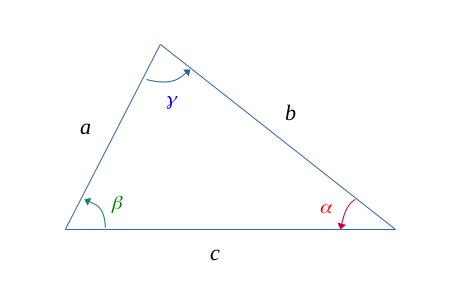
Relationships between lengths and angles
Law of sines
$$\forall (a, b, c) \in \hspace{0.05em} \mathbb{R}^3, \enspace \forall (\alpha, \beta, \gamma) \in \hspace{0.05em} \mathbb{R}^3, $$
$$ \frac{sin(\alpha)}{a} = \frac{sin(\beta)}{b} = \frac{sin(\gamma)}{c} $$
Al-Kashi's theorem
$$\forall (a, b, c) \in \hspace{0.05em} \mathbb{R}^3, \enspace \forall (\alpha, \beta, \gamma) \in \hspace{0.05em} \mathbb{R}^3, $$
$$ a^2 = b^2 + c^2 - 2bc.cos(\alpha) \qquad (Al-Kashi) $$
$$ b^2 = a^2 + c^2 - 2ac.cos(\beta) \qquad (Al-Kashi^*) $$
$$ c^2 = a^2 + b^2 - 2ab.cos(\gamma) \qquad (Al-Kashi^{**}) $$
Methods of calculating areas
Area formula
$$\forall (a, b, c) \in \hspace{0.05em} \mathbb{R}^3, \enspace (\alpha, \beta, \gamma) \in \hspace{0.05em} \mathbb{R}^3, $$
Héron's formula
Héron's formula tells us that:
$$\forall (a, b, c) \in \hspace{0.05em} \mathbb{R}^3,$$
$$ S_{abc} = \sqrt{p(p-a)(p-b)(p-c)} \qquad (Héron) $$
$$ avec \enspace \Biggl \{ \begin{gather*}
p : half\hspace{-0.3em}-\hspace{-0.3em}perimeter \ of \ a \ triangle \\
p = \frac{a+b+c}{2}
\end{gather*} $$
Demonstration
To show it, let us project a height \( h_c \) upon the length \( c \), and such as the following figure:

Straightaway, the following relations come:
$$ sin(\alpha) = \frac{h_c}{b} \qquad (1) $$
$$ sin(\beta) = \frac{h_c}{a} \qquad (2) $$
Dividing the equation \( (1) \) by \( a \), we do have:
$$ \frac{sin(\alpha)}{a} = \frac{h_c}{ab} \qquad (3) $$
In the same way, dividing \( (2) \) by \( b \):
$$ \frac{sin(\beta)}{b} = \frac{h_c}{ab} \qquad (4) $$
We now notice that both right memebers of \( (3) \) and \( (4) \) are equals, it follows that:
$$ \frac{sin(\alpha)}{a} = \frac{sin(\beta)}{b} \qquad (5) $$
By reproducing this operation on the two others lengths, we will have two new equations:
$$ \frac{sin(\beta)}{b} = \frac{sin(\gamma)}{c} \qquad (6) $$
$$ \frac{sin(\gamma)}{c} = \frac{sin(\alpha)}{a} \qquad (7) $$
Equalities \( (5), (6), (7) \) having a common member from one to another, they are all equals.
And finally,
$$\forall (a, b, c) \in \hspace{0.05em} \mathbb{R}^3, \enspace (\alpha, \beta, \gamma) \in \hspace{0.05em} \mathbb{R}^3, $$
$$ \frac{sin(\alpha)}{a} = \frac{sin(\beta)}{b} = \frac{sin(\gamma)}{c} $$
In all these demonstrations, we will demonstrate the theorem for only one of the three sides. Afterward the two other demonstrations are trivial.
-
With the Pythagorean theorem
-
Case of an acute triangle
To demonstrate the theorem, we have projected the height \( h_c \) on the side \( c \) to obtain the following figure:
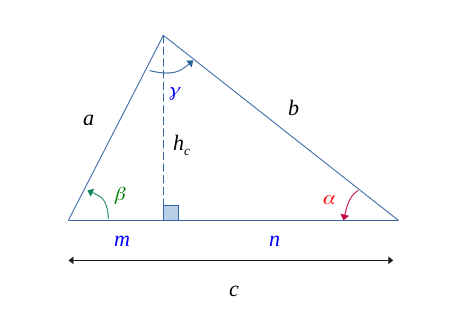
In the small triangle \(\{a, h_c, m\}\), the Pythagorean theorem gives us:
$$ a^2 = m^2 + h_c^2 $$
$$ a^2 = (c-n)^2 + h_c^2 $$
$$ a^2 = c^2 - 2cn + n^2 + h_c^2 \qquad (1) $$
Now, in the other triangle \(\{b, h_c, n\}\),
$$ n^2 + h_c^2 = b^2 \qquad (2) $$
But also,
$$ cos(\alpha) = \frac{n}{b} \Longleftrightarrow n = b.cos(\alpha) \qquad (3) $$
Injecting \((2)\) and \((3)\) into \((1)\), we do have now:
$$ a^2 = c^2 - 2cb.cos(\alpha) + b^2 $$
And finally,
$$\forall (a, b, c) \in \hspace{0.05em} \mathbb{R}^3, \enspace \forall \alpha \in \mathbb{R}, $$
$$ a^2 = b^2 + c^2 - 2bc.cos(\alpha) \qquad (Al-Kashi) $$
-
Case of an obtuse triangle
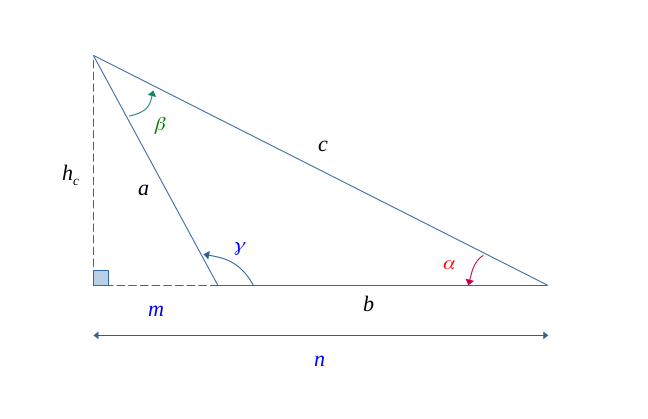
In the same way, in the small triangle \(\{a, h_c, m\}\), the Pythagorean theorem gives us that:
$$ a^2 = m^2 + h_c^2 $$
$$ a^2 = (n-b)^2 + h_c^2 $$
$$ a^2 = n^2 - 2nb + b^2 + h_c^2 \qquad (4) $$
Now, in the other triangle \(\{h_c, n, c\}\),
$$ h_c^2 + n^2 = c^2 \qquad (5) $$
But also,
$$ cos(\alpha) = \frac{n}{c} \Longleftrightarrow n = c.cos(\alpha) \qquad (6) $$
Injecting \((5)\) and \((6)\) into \((4)\), we do have now:
$$\forall (a, b, c) \in \hspace{0.05em} \mathbb{R}^3, \enspace \forall \alpha \in \mathbb{R}, $$
$$ a^2 = b^2 + c^2 - 2bc.cos(\alpha) \qquad (Al-Kashi) $$
-
By the scalar product
Considering the lengths \(a, b, c\) as three vectors, and such as the follwing figure:

Then, we do have applying the Chasles relation:
$$ \vec{a} = \vec{b} - \vec{c} \qquad (7) $$
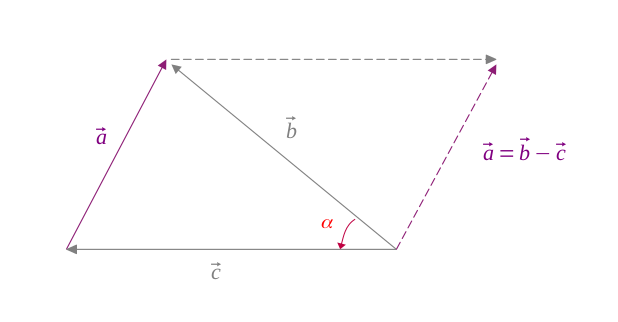
So,
$$ \vec{a}.\vec{a} = {|| \vec{a} ||}^2$$
Injecting \((7)\) into it, we now have:
$$ (\vec{b} - \vec{c})^2 = {|| \vec{a} ||}^2$$
Likewise, with the scalar product remarkable identities, we do have the following property:
$$ \forall (\vec{u}, \vec{v}), $$
$$ (\vec{u} - \vec{v})^2 = {|| \vec{u} ||}^2 - 2 \vec{u}.\vec{v} + {|| \vec{v} ||}^2 $$
So in our case,
$$ {|| \vec{b} ||}^2 - 2 \vec{b}.\vec{c} + {|| \vec{c} ||}^2 = {|| \vec{a} ||}^2$$
$$ b^2 - 2 bc \ cos(\vec{b}, \vec{c}) + c^2 = a^2 $$
And finally,
$$\forall (a, b, c) \in \hspace{0.05em} \mathbb{R}^3, \enspace \forall \alpha \in \mathbb{R}, $$
$$ a^2 = b^2 + c^2 - 2bc.cos(\alpha) \qquad (Al-Kashi) $$
-
Conclusion
We demonstrated the first formula of the theorem:
$$ a^2 = b^2 + c^2 -2bc.cos(\alpha) \qquad (Al-Kashi)$$
Repeating the same process again on the other sides of the triangle we can retrieve two other expressions.
$$ b^2 = a^2 + c^2 - 2ac.cos(\beta) \qquad (Al-Kashi^*) $$
$$ c^2 = a^2 + c^2 - 2ab.cos(\gamma) \qquad (Al-Kashi^{**}) $$
To demonstrate this, let's project a height \( h_c \) along the length \( c \), and such as the following figure:
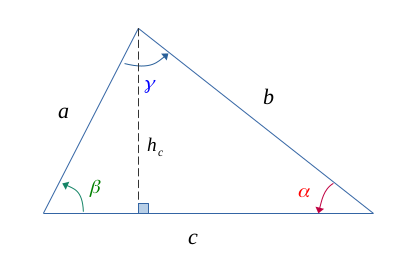
Immediately, the following relationships come:
As a result, it follows that:
But, the formula for the area of any triangle \(\{a, b, c\}\) is worth:
$$ S_{abc} = \frac{1}{2}c.h_c \qquad (\mathcal{A}) $$
Now, by injecting the values of \(h_c\) coming from \((1')\) and \((2')\) in that of \((\mathcal{A})\), we obtain the double equality:
Finally, by projecting one of the other two heights, we find the third equality, and finally:
$$\forall (a, b, c) \in \hspace{0.05em} \mathbb{R}^3, \enspace \forall (\alpha, \beta, \gamma) \in \hspace{0.05em} \mathbb{R}^3, $$
To demonstrate this formula, we project the height \( h_c \) as before along the length \( c \):

Thanks to Al-Kashi's theorem, we have the following relationship:
$$ a^2 + b^2 - 2ab.cos(\gamma) = c^2 $$
$$ a^2 + b^2 - c^2 = 2ab.cos(\gamma) $$
And then,
$$ \frac{a^2 + b^2 - c^2}{2ab} = cos(\gamma) \qquad (3) $$
But, we know that:
$$ sin^2(\gamma) = 1 - cos^2(\gamma) $$
$$ sin^2(\gamma) = \bigl(1 - cos(\gamma)\bigr)\bigl(1 + cos(\gamma)\bigr) \qquad (4) $$
Now injecting the expression \((3)\) into the expression \((4)\), we do have this:
$$ sin^2(\gamma) = \left(1 - \frac{a^2 + b^2 - c^2}{2ab} \right)\left(1 + \frac{a^2 + b^2 - c^2}{2ab}\right) $$
$$ sin^2(\gamma) = \left(\frac{2ab}{2ab} - \frac{a^2 + b^2 - c^2}{2ab} \right)\left(\frac{2ab}{2ab} + \frac{a^2 + b^2 - c^2}{2ab}\right) $$
$$ sin^2(\gamma) = \left(\frac{2ab - (a^2 + b^2 - c^2)}{2ab} \right)\left(\frac{2ab + (a^2 + b^2 - c^2) }{2ab}\right) $$
$$ sin^2(\gamma) = \left(\frac{2ab - a^2 - b^2 + c^2}{2ab} \right)\left(\frac{2ab + a^2 + b^2 - c^2 }{2ab}\right) $$
Arranging both parenthesis in order to obtain remarkable identities:
$$ sin^2(\gamma) = \left(\frac{-(a^2 + b^2 - 2ab) + c^2}{2ab} \right)\left(\frac{a^2 + b^2 + 2ab - c^2 }{2ab}\right) $$
$$ sin^2(\gamma) = \left(\frac{c^2 -(a-b)^2}{2ab} \right)\left(\frac{(a+b)^2 - c^2 }{2ab}\right) $$
We now factorize to obtain the third remarkable identity:
$$ sin^2(\gamma) = \left(\frac{\bigl(c - (a-b)\bigr)\bigl(c + (a-b)\bigr)}{2ab} \right)\left(\frac{ \bigl((a+b) -c \bigr)\bigl((a+b) + c \bigr)}{2ab}\right) $$
We remove the parentheses:
$$ sin^2(\gamma) = \left(\frac{(c-a+b)(c+a-b) }{2ab} \right)\left(\frac{ (a+b-c)(a+b+c) }{2ab}\right)$$
$$ sin^2(\gamma) = \frac{(c-a+b)(c+a-b)(a+b-c)(a+b+c)}{4a^2b^2} \qquad (5) $$
Moreover, we have seen more with the area formula that:
$$ S_{abc} = \frac{1}{2}ab . sin(\gamma) $$
And then also that:
$$ (S_{abc})^2 = \frac{1}{4}a^2b^2 . sin^2(\gamma) \qquad (6)$$
So, by injecting the expression \((5)\) into the expression \((6)\), we do have:
$$ (S_{abc})^2 = \frac{1}{4}a^2b^2 . \frac{(c-a+b)(c+a-b)(a+b-c)(a+b+c)}{4a^2b^2}$$
Putting the elements in order, we now have:
$$ (S_{abc})^2 = \frac{1}{16}(a+b+c) (a+b-c)(b+c-a)(a+c-b) $$
At this stage, let us introduce the perimeter \(P\) of the triangle, then the expression becomes:
$$ (S_{abc})^2 = \frac{1}{16}P (P - 2c)(P - 2a)(P - 2b) $$
Then that of half-perimeter \(p\) :
$$ (S_{abc})^2 = \frac{1}{16}2p (2p - 2c)(2p - 2a)(2p - 2b) $$
We factorize all expressions in parentheses by \(2\):
$$ (S_{abc})^2 = \frac{1}{16} \times 2p \times 2(p - c) \times 2(p - a) \times 2(p - b) $$
$$ (S_{abc})^2 = p (p - c)(p - a)(p - b) $$
And finally,
$$\forall (a, b, c) \in \hspace{0.05em} \mathbb{R}^3,$$
$$ S_{abc} = \sqrt{p(p-a)(p-b)(p-c)} \qquad (Héron) $$
$$ avec \enspace \Biggl \{ \begin{gather*}
p : half\hspace{-0.3em}-\hspace{-0.3em}perimeter \ of \ a \ triangle \\
p = \frac{a+b+c}{2}
\end{gather*} $$












 Go to the top of the page
Go to the top of the page